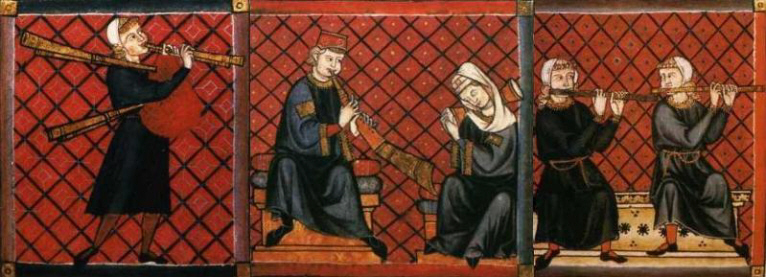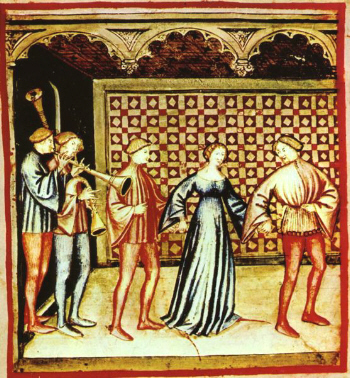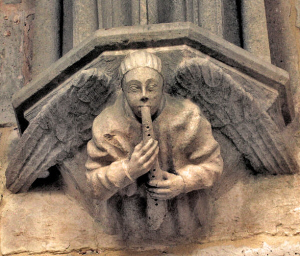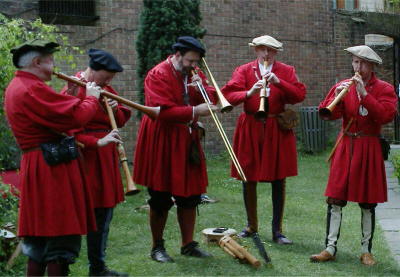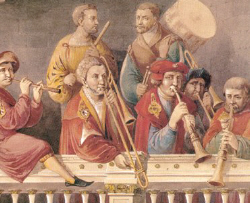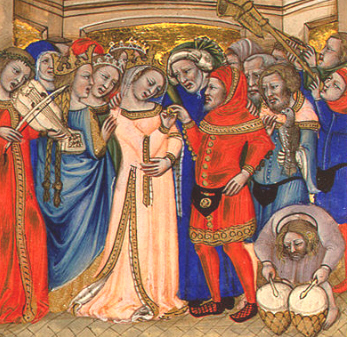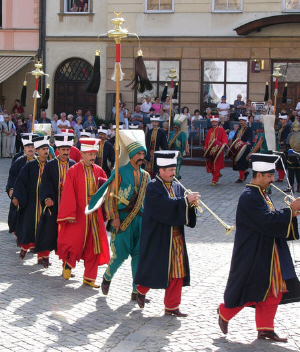1
|
||
Then I saw standing behind them, far away and all by themselves, many scores of thousands, who made loud minstrelsy with bagpipes and shawms and many other kinds of pipes, and skillfully played both them of clear and them of reedy sound, such as be played at feasts with the roast-meat,--and many a flute and lilting-horn and pipes make of green stalks, such as these little shepherd-lads have who watch over beasts in the broom.1 The information on the wind band in the medieval period of Western Europe is sketchy at best. Written examples of music from this time are at a premium, and even less is written of instrumental music. But from humble beginnings comes an interesting story of how wind music fit into the society of the time. The middle Ages in Europe had very little to recommend. It was a time of poverty, famine, and feudal servitude for the mass population - and if these weren't enough, at various times war and plague ravaged the land. But it was also a time of new beginning as the populace struggled to emerge from what has been referred to as the Dark Ages. The concept of individual rights and limited monarchy saw light in documents such as the Magna Charta. And while one might question the political motives behind the Catholic Church sending "Crusaders" from across Europe to rescue Palestine from Islam, the consequence was the exposure of Western Europe to a part of the world from which it had long been isolated. This was the era of Romanesque and Gothic architecture best exemplified in the great Cathedrals of Europe. It was also a period of great literature including Chaucer's Canterbury Tales, Boccaccio's The Decameron, Dante's Comedy, and the writings of Hildegard of Bingen. Furthermore, the increasing popularity of Scholastic philosophy had no greater representative than Thomas Aquinas. Monastic schools, long considered the principal centers of learning, were first replaced by cathedral schools, and later, universities. But from the monastic schools to the universities with their more divergent curriculum, most literate people still had ties to the Church. Roger Bacon, for example, in addition to being the chief forunner of the scientific method of observation and experiment was a Franciscan monk, and Thomas á Becket was an archdeacon prior to his appointment as Chancellor of England. So many references of society, music, literature, etc., came from the pen of the clergy. This explains why Medieval Latin treatises such as the Musica enchiriadis, dating from the 9th century (or earlier), ignore secular music, because their primary interest was music of the Church. Reference to secular music including instrumental music would not appear until after 1150, requiring contemporary scholars to speculate as to the type of music to which the common folk danced and sang.2 THE BEGINNING OF THE MEDIEVAL WIND BANDThrough available writings it has become apparent that traveling poets and musicians known as jongleurs or minstrels were a key element in medieval instrumental music. The jongleurs (the literal meaning is French for jugglers) were vagabonds whose somewhat unsavory lifestyles and music were often looked down upon by society as a whole.3 As a rule, today's classically trained musicians are specialists on one instrument, but musicians during this time were required to be adept at a variety of skills, not all of them musical, in order to be as marketable as possible: I can play the lute, vielle, pipe, bagpipe, panpipes, harp, fiddle, guittern, symphoy, psaltery, orginistrum, organ, tabor and the rote. I can sing a song well, and make tales to please young ladies, and can play the gallant for them if necessary. I can throw knives into the air and catch them without cutting my fingers. I can jump rope most extraordinary and amusing. I can balance chairs, and make tables dance. I can somersault, and walk doing a handstand.4 Since most of these entertainers were neither poets nor composers, they were always looking for a chance to learn new material. One opening was during the season of Lent each year when employment opportunities dwindled. During this period of "time off" musicians added to their repertoire by attending so-called "schools" of minstrelsy where the musicians could gather and hone their skills by playing together and learning new songs.5 Perhaps it was while visiting such a school that the above quote from Chaucer was inspired. Most likely these gatherings of musicians led to ensemble performances, and large ones at that.6 As mentioned, it is impossible to provide a complete picture of performance practice during this time due to a lack of references that describe both how instruments were played and how they sounded. However, it does seem evident that medieval audiences preferred to use a variety of instruments with various tonal colors. The celebrated composer Guillaume de Machaut describes a fourteenth century concert in which 31 different instruments were used in an ensemble by a total of over fifty performers.7 The enormous color possibilities of such an ensemble must have been intriguing, but one can only imagine what kind of intonation problems arose! In time the Jongleur gave way to the minstrel who claimed fewer but more refined skills. The minstrel, however, still suffered from the prejudice and stigma associated with the life of an itinerant. They had no civic status to speak of, unless they were associated with some particular court, and their civil rights were minimal. This prompted the minstrels performing in cities to form guilds similar to those found in other trades. Not unlike today's labor unions, the guild provided a level of social acceptance, legal protection, and integration into the urban society not enjoyed before. The guild also provided aid for sick and retired members, and worked to guarantee that all local performances would be limited to its own members, while excluding itinerant performers. The traveling musicians, with their colorful lifestyle, in time faded into history, replaced by the court and town musicians whose responsibilities furthered the establishment of the wind band.8 - Back to top -SLOW ACCEPTANCE OF WIND INSTRUMENTS INTO THE CHURCHGenerally, the church discouraged the use of instruments in worship--a practice dating back to the first century. While there are several references of instrumental music used in worship found in the Old Testament books of Jewish history (II Chronicles 7:6, 29:25-28) and the Psalms (81:2-3, 98:4-6, 150), New Testament references are found only in the apocalyptic writings of heaven in the book of Revelation (11:5, 15:3). As a result, for centuries instruments were forbidden in the church as a matter of precedence since early writings indicate that first century church music was sung a cappella. Other reasons for exclusion may have included (1) the question of safety since loud instruments could potentially divulge the secret worship place of Christians facing persecution, and (2) guilt by association due to prevalent use of instruments in idol worship. Centuries later, the stigma against using instruments in worship remained since instruments were still associated with the more amoral elements of society. So the information concerning instrumental music during the middle ages is quite sketchy. Eventually information became increasingly available due to (1) the increased demand for instrumental music in the courts and cities, (2) the regular use of instruments in churches such as St. Mark's in Venice, and (3) the advent of a more literate society spurred by the Renaissance and the invention of the printing press. Instruments found a place in the church as early as the seventh or eighth century, especially the organ. Its acceptance increased as mechanical improvements made it more functional. But even in the twelfth century other instruments were still forbidden. Despite their general absence in the worship service, the clergy found plenty of other opportunities to hire instrumentalists. For example, as early as the appointment of Gregory IX, in 1227, wind instruments are used to enhance the festive atmosphere of the Pope's coronation. During the fourteenth century, many German bishops provided for their own private minstrels. Also, at large gatherings the more exalted clergy customarily brought wind players to provide additional "pomp and circumstance" to the occasion. If none were on staff, then an ensemble was hired, as was the case when the Pope made his entrance with trumpets, drums, and shawms [predecessor of the oboe] at the Councel of Florence in 1438.9 Instrumental ensembles were used frequently in church sponsored parades and festivals, and they also found their way inside the church building with the advent of the medieval drama (plays which used Bible stories, or dramatic representations of biblical subjects such as the life of Jesus, or the creation). In time instrumental ensembles performed at aristocratic marriages and baptisms as well as masses on certain festival days. Instruments used on these occasions included shawms, trombones, horns, trumpets, a variety of percussion (drums, tambourine, and nakers [small Turkish kettledrum]), and strings.10 - Back to top -MEDIEVAL CIVIC BANDSThe Trumpeter of CracowA particularly romantic story centers around the trumpeter for the city of Cracow in 1241 who blew a warning that the Tartar hordes were approaching the city. In the middle of the fanfare an arrow pierced his neck, abruptly ending the call for alarm. As a tribute to the early trumpeter, custom to this day dictates that the trumpeters perform this fanfare in his honor. Cracow still maintains six tower trumpeters. Conditions are more congenial for today's watchmen as the tower is provided with a television set, a heater, and a hot plate to cook soup.1Wind players increasingly found their services needed in a variety of divers settings. For example, it was customary for cities of the middle Ages to be surrounded by walls for security. Watchmen were employed in towers along the walls in order to keep an eye out for human predators, or fire, which could quickly destroy an entire town. Initially bells were placed in towers to communicate signals, while trumpets were added late in the twelfth century. The trumpeter was more valuable as an alarm because, through specific signals, the citizens could be alerted to a specific quadrant of the town where a fire or other emergency was occurring. Eventually the musicians took on other functions such as announcing the time of day (especially important at night when the town clock was not visible) and the time of dawn as a warning to lovers that it was time to escape to a more acceptable abode. The BandwagonAcross Europe there were common practices regarding the growth of the wind band, as well as elements unique to a particular country, region or even a city proper. One such development was the medieval band wagon in Italy. The picture of a band wagon usually connotes thoughts of a late nineteenth century horse drawn vehicle heralding the arrival of the circus to town. In fact, references date its use as far back as 1037, when Aribert, Archbishop of Milan, sought to organize the resistance of the people against the occupation of the Franconian King Conrad II. A large wagon called a carroccio was built to hold an altar, the civic flag, and eight trumpeters who played a fanfare to assemble the people. The wagon also carried priests into the battle where they gave last rites for those killed in the resistance, after which the trumpeters played a fanfare signaling the battle to continue. In peace the wagon was used at various civic functions. A number of other cities provided for such wagons, including Florence and Venice.2Still later the duties of the Watchmen expanded to such events as playing for announcements of important news, and parades of prisoners or prostitutes being taken to floggings. By the end of the thirteenth century, civic musicians also provided music at civic entertainment functions, such as banquets for dignitaries, fairs and dances. The musicians became more adept in their music capabilities as the old buisine [old style of trumpet, straight pipe with a flare at the end] was replaced by an improved trumpet, the slide trumpet was developed, and improvements were made on the shawm. Very gradually, the responsibility of players evolved from sounding alarm calls of danger to the inception of the concert performance. By the thirteenth century some Italian cities began to have regularly paid civic bands. The city of Florence required both summer and winter uniforms for the musicians, so as to serve the city more honorably, and by the end of the fourteenth century it maintained three different ensembles. The responsibilities for civic bands grew to include daily performances, public celebrations of patron saints, feast days and regional celebrations inaugurated by the local aristocracy. Venice was particularly known for its elaborate parades around the plaza of St. Mark's in celebration of trade or treaty agreements made with other cities or states. - Back to top -Great BritainIn England, the tower musician was referred to as the "watch" or "wait". The musicians were originally hired on for singular duty, but increasing responsibilities eventually led to the creation of civic bands. Fourteenth century records indicate civic bands present not only in London, but also Leicester, Exeter, and York. As in Italy, many of the earliest references mention events such as the annual mayor's procession in London known as the Lord Mayor's Day. Even some of the more prosperous guilds had their own bands in either limited or regular employment for such occasions as the annual parade on Guild's Day in London. By the fifteenth century, not only did the number of cities employing bands grow, but bands became known for their uniform dress or "hoods" representing their particular city. The competition between cities no doubt became keen as different municipalities vied for the most splendid regalia. Eventually the function of "Wait Bands" focused less on night protection and more on public performance, although in 1457 the night shift for the eight town waits in Dublin still demanded them: ...to perambulate the city nightly from curfew to five in the morning... for which they would receive... four pence of every hall and three pence of every shop within the city bounds. In London a similar order required the waits to make nightly walks not only to prevent robberies, but also to entertain the people.11 The transition from tower to civic bands was similar in the Low Countries, with the addition of banquet concerts given after the meal for the guests. Instead of dinner music, these events were an actual concert of sorts, most of the repertoire consisting of transcribed vocal polyphony. The instructions concerning obligations and repertoire required of the 15th century town band of Bruges in Burgundy were quite specific: ...each of them are obligated to play at the front of the old hall at the customary place on all Sundays and Holy Days at 11:00 before noon and at 6:00 in the evening from Easter to Baefmess [Feast of St. Bava, held on October 1st], and from Baefmess to Easter at 3:00 in the afternoon; they are to play two chansons [liedekens] or motets [moteten] at each performance; each performer is to appear in livery and sign the work book.12 - Back to top -FranceThe information concerning civic bands in France suggests much the same progression of activities as already noted. Of particular interest are some of the requirements dictated in the minstrel by-laws of Paris dating from the year 1321. These included: 1. A musician was required to remain at an engagement until its conclusion rather than leaving to take on a new engagement. - Back to top -German CountriesThe German provinces also provided for musicians to perform many of the same duties mentioned above. These included playing for tower watch, weddings (as early as the 12th century), civic ceremonies, and festivals. The musicians also formed guilds in the more established cities. While references to actual concerts are fewer, eventually it became tradition to play chorales from civic towers at specific times during the day. These pieces were possibly performed by a quartet made up of three shawms and a sackbut [early trombone] or slide trumpet.14 - Back to top -COURT WIND BANDSEventually the wind band was provided with a more secure place in the social fabric of civic society. The early use of trumpets and drums in the West was for heralding the ceremonious movements and occasions of royalty and high nobility. The particular instrument of heralds was the high-pitched clarion [short trumpet, old English round trumpet], while the long trumpet (buysine) seems to have been played at such court events as tournaments and banquets. With the increasing use of the imperious sound of clarions to punctuate events of high social ritual, players of these instruments became indispensable to the entourage of persons of high rank. They and the trumpeters were the most highly regarded and the best paid of the growing new class of "minstrels"--properly so called because they were paid members of the retinue (ministerium) of great personages. Playing individually or in groups -- in contrast to the earlier competitive individualism of jongleur and harper -- the ministralli, a term that included heralds, trompours, nakertters, harpers, pipers, tabourers, etc., formed themselves into guilds., They thus became the organized keepers and transmitters of an unwritten repertory and the art and craft of playing it.15 Medieval ensembles were divided into two types -- "loud" and "soft". The loud ensembles were the pure wind bands and selected their numbers from the trumpet, trombone, shawm, horn, bagpipe, and percussion families. They typically played for outside and large room events, while the soft ensemble, made up of flutes, recorders, lute and keyboards, performed in smaller chambers.16 Since trumpets were considered the exclusive domain of the nobility, they were used to herald the occasion of the visit of ruling dignitaries both far and near, as well as providing the correct "pomp and circumstance" for the ceremonies which went with such occasions. They also provided a "call to dinner" for larger banquets as well as music for such courtly events as masquerades and the mummer's play (activities involving the wearing of masks or disguises). Tournaments or jousts enjoyed the timbre of both trumpets and drums to accent the occasion, while horns were expected to call the hunt. Wind bands also followed aristocrats into battle. Dancing provided the medieval court with much pleasure. One of the most prominent dances of the late medieval period was the basse-dance (a solemn dance with gliding steps) which likely was complemented by shawms and a bagpipe (later replaced by a slide trumpet).17 History records musicians complementing a variety of other activities. Edward I (1272-1307) brought in minstrels from all over Europe for the knighting of Edward II, while 426 minstrels were employed for the marriage of his daughter. Weddings and coronations provided a splendid opportunity for wind bands to turn out in mass. Eyewitnesses of the wedding of Henry V (1413-1422) to Catherine, daughter of Charles VI of France, and her subsequent coronation a year later suggest the appearance of large numbers of minstrels for both events. - Back to top -INFLUENCE FROM THE EASTThe European aristocracy was exposed to a variety of styles of music due, in part, to travel throughout Europe, but also due to exposure to exotic regions such as those experienced during the crusades. Spices, gunpowder, and mathematics were only part of the influence the near and far east had on Western European. The Europeans encountered the Saracens of the Ottoman Empire from the time of the crusades to the declining years of the nineteenth century. And from this exposure Europeans acquired a fascination for the instruments and exotic sounds of the Saracen bands. Through the Seracens Europeans first encountered shawms, cymbals, triangles, drums such as nakers, and eastern forms of trumpets (an alternative to the French word for buicine was "sarrazinois" or Saracen horn). Europeans were captivated by these exotic sounds and held particular interest for the percussion instruments (cymbals, triangle, crescent, bass drum, timpani)--an interest that remained high through the late eighteenth and early nineteenth century, as heard in Mozart's Die Entführung aus dem Serail (Abduction from the Seraglio), Beethoven's Symphony No. 9, and Spohr's Notturno. Pseudo-Turpin, in his chronicles of the crusade of Charlemagne said that the sounds of the Saracen's nakers were so intimidating to the Christians that they were compelled to cover the eyes and ears of their horses. The Sultan Baibar (d.1277) reportedly had a military band consisting of 20 trumpets, 40 timpani, four shawms, and four drums for a total of 68 players. Not only were the bandsmen required to give signals for battle, but the sheer enormity of the sound they generated was in itself a strategy to provoke terror in their enemy.18 Earlier, during what was known as the Third Crusade (1189-1192), Geoffrey de Vinsauf in chronicling the exploits of Richard the Lion-Hearted described an encounter with the enemy from the east: They came on with irresistible charge, on horses swifter than eagles, and urged on like lightening to attack our men; and as they advanced, they raised a cloud of dust, so that the sky was darkened. In front came certain of their admirals, as it was their duty, with clarions and trumpets; some had horns, others had pipes and timbrels, gongs, cymbals, and other instruments, producing a horrible noise and clamour. The earth vibrated from the loud and discordant sounds, so that the crash of thunder could not be heard amidst the tumultuous noise of horns and trumpets. They did this to excite their spirit and courage, for the more violent the clamour became, the more bold were they for the fray19. Süleyman's Mehter BandAt its zenith during the reign of Süleyman the Ottoman Empire stretched from Persia across Arabia and northern Africa up to within striking distance of Venice and Vienna. Marching up the Danube across the Hungarian steppe, his army laid siege to Vienna in 1529. Perhaps it was on this campaign that one survivor described the mehter or military band of Süleyman at its most harrowing: When they pass all playing at the same time, the noise of them presses men's brains out of their mouths.3Richard, who was a trouvere [12th-13th century poet-musician], allowed for certain tales to be told about his endeavors by other musicians. On this crusade he had both the tuba and the buccina with him. Not only were trumpets used for battle signals, but his fleet, arranged in a large pyramid fashion, was carefully spaced so as to also respond to signals.20 While Europeans held a certain fascination for exotic instruments of the Ottoman Empire, the Turks were not necessarily allowed to reciprocate. In his Syntagma Musicum, Praetorius relates how Francis I King of France sent a large and costly instrument (along with several musicians to play it) to Sülayman (Soloman) the Magnificent as a gift during his first year of rule in 1520. In time as the people became somewhat enamored with the western sounds, the Turkish king had the instrument smashed and burned, lest the populace become too soft and effeminate, as he alleged.21 In the realm of medieval war, the mehter were held in high regard, both as a distractor of the enemy, and as an encouragement to excite the soldiers to battle. Indeed they enjoyed a close place to the colors or insignia of the sultan or amir, as well being allotted special places in camp or barracks. It was considered an especially grievous loss to lose the instruments to the enemy, while capturing the enemy's instruments was a special prize to be displayed quickly for all to see.22 CONCLUSIONInstrumental music of the middle Ages served a variety of purposes, from municipal and court entertainment to use in the thick of battle. From this most disparate background came an increasing use of a variety of instruments in society, for personal as well as public entertainment. Music written solely for instrumental purposes would be published and performed in a variety of venues during the upcoming Renaissance. - Back to Top -
|
||
